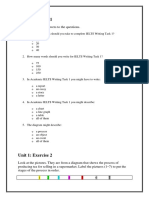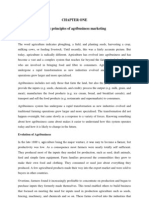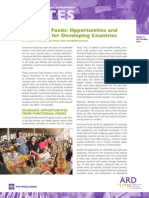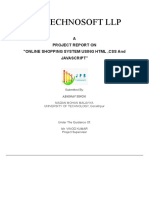Module 1 - The AFI
Module 1 - The AFI
Uploaded by
rbtlch1nCopyright:
Available Formats
Module 1 - The AFI
Module 1 - The AFI
Uploaded by
rbtlch1nOriginal Description:
Original Title
Copyright
Available Formats
Share this document
Did you find this document useful?
Is this content inappropriate?
Copyright:
Available Formats
Module 1 - The AFI
Module 1 - The AFI
Uploaded by
rbtlch1nCopyright:
Available Formats
HSC Food Technology
Summary
, foo20/10/09-
Module 1: The Australian Food Industry
Students learn about:
x Sectors of the agri-food chain in the Australian food industry,
including agriculture and fisheries, food
processing/manufacturing, food service and catering, food retail
The agri-food chain refers to the production and supply of food to consumers
x The AFI aims to provide a regular supply of a variety of palatable foods with
reasonable shelf life and is responsible for the management of natural resources
Sectors of the AFI
x Production and supply of food known as the agri-food chain
x The sectors of the AFI are:
1. Agriculture and fisheries
2. Food processing and manufacturing
3. Service and catering
4. Retail
Agriculture and Fisheries
Trends include:
-using technology to overcome harsh conditions
-Contribution to export markets of agriculture and fisheries
-large-scale production of animals/related products
-large variety of crop production
-↑ aqua-culture market
Examples of Agriculture and Fisheries organizations:
-Australian Wheat Board
Food Processing and manufacture
x Food processors may use simple value adding techniques e.g. packaging mixed
lettuce or complex techniques e.g. turning milk into cheese
x Trends include:
-Value added foods e.g. Aussie wheat made into bread (also ↑ employment
opportunities)
-more manufactured foods
-mechanisation of food processing to reduce cost of labour
Robert Lee Chin 1
HSC Food Technology
Summary
-Many manufacturers are multinational companies (e.g. Bulla, SPC, Lowans, San
Remo)
-Diverse industry ranging from home business to multinational companies
Food Retail
x Trends include:
-larger supermarkets over convienience stores
-Speciality chain stores (e.g. Red Lea)
-changing work hours resulting in 24 hr and Internet shopping
-↑ consumption of convienience foods
-↑ fresh food chains due to ↑ health awareness
Food Service and Catering
Prepares foods ready-to eat and includes restaurants, takeaway, airline catering,
canteens and function catering (e.g. wedding).
Trends include:
- non-commercial meals- Foods provided in institutions (e.g. aged care)
-Commercial meals- foods produced for sale (e.g. restaurants)
-Home delivery ↑ (e.g. Dominos, Red Rooster, Nando’s)
-One in four meals eaten away from home
Aspects
of the
AFI
1) Level of 2) Research 3) Quality 4) Impact of: 8) Career and
Operation & Assurance Consumer “ “ “ working
Development Influences on the AFI opportunities
5) Society 6) Economy 7) Environment
Robert Lee Chin 2
HSC Food Technology
Summary
x Operation of organisations within the Australian Food Industry
with particular attention to:
-levels of operation and mechanisation, including household, small
business, large companies, multinational
Level of Operation refers to the scale and level of technology used in food production
The level of technology (e.g. mechanisation, computerisation) ↑ with the size of an
operation. This ↑ job opportunities and employment.
Trends:
-Larger companies have greater influence on food issues
-Multinational companies are taking over large Aussie businesses
Level Description Feature Example
Household Home produce/manufactured Small scale with low Local selling
goods tech. levels home-made preserves
Small business Family business/partnership Usually local Chinese grocer
Usually >20 staff
Large business Operates across state/nation Usually has several Arnott’s
owners servicing the Tip top
wider community
Multinational Operates in many countries Large scale and global McDonalds
Subway
Coca Cola
-research and development
Research and development is process used to create new products as result of competition.
It is $$, so funding usually comes form other organisations. Government research is
performed by the CSIRO for a variety of sectors. Government bodies such as FSANZ
also fund research into areas that impact the Food Standards Code. Factors influencing
R&D include pressure to produce innovative foods from consumers and competing
companies.
Features include:
-↑marketplace (e.g. ethnic foods) and diverse consumer needs (e.g.
health conscious groups)
-Government research in food industry (e.g. CSIRO)
Robert Lee Chin 3
HSC Food Technology
Summary
Development Sector/s Explanation
One-stop shopping Retail Large shopping centres that supply a
wide range of food products (e.g. Coles)
Irrigation Agriculture and fisheries Providing water for agriculture
Convenience meals Processing and Provides readily available no fuss meal
manufacture options esp. for busy, working people
Aquaculture Agriculture and fisheries Controlled breeding programs (e.g. Fish
farming)
Home delivery service Food service and catering Food is ordered via phone and delivered
to location (e.g. Dominos)
Genetic engineering Agriculture and fisheries Foods have their genes modified to
produce higher yields, disease
resistance, superior nutrition
Value added foods Processing and Foods are processed into other products
(rather than primary manufacture (e.g. wheat into bread)
produce)
Internet shopping Retail Foods ordered via internet
Breeding leaner meats Agriculture and fisheries to meet consumer demands for healthier
options
Pollution control Agriculture and fisheries Protects the environment, resources and
Processing and industries. Aids consumer image of
manufacture company.
Australia’s ‘clean Agriculture and fisheries Strict production controls ensures
green’ image Processing and consumer quality esp. to compete with
manufacture overseas market
Production of low-fat Agriculture and fisheries Meet demands of health conscious
animal products Processing and consumers. Potential for larger range of
manufacture processed foods
Product scanning Retail Each product has its own unique
Processing and barcode that contains product
manufacture information and allows for inventory
tracking
-quality assurance
Quality assurance is the responsibility of EVERY person involved in food
production, from raw materials to processing and retailers.
Features of quality assurance:
-Guaranteed through strict quality control procedures
-Consumer support ensures consumer satisfaction (e.g. Consumer Affairs
Bureau, CHOICE)
-customer complaint procedures (e.g. “Money back guarantee”)
-HACCP (Hazard Analysis Critical Control Points), an International approach
to quality assurance
Robert Lee Chin 4
HSC Food Technology
Summary
-consumer influences
Social Trends Changing Demands Example products
↑ single parent families Low cost nutritious foods Cheaper cuts of meat
Fruit and vegetables in season
↑ dual income families Value-added quickly
prepared meals
↑Home meal replacements
↑ mobile population ↑take-away ↑take-away e.g. chips, burgers
busier lifestyles ↑instant foods Prepared sauces
frozen vegetables
↑ environmental ↑demand for foods produced ↑Organic foods
concerns environmentally friendly ↑Recyclable/reusable
packaging
↓ family size ↓ use of cheaper, ‘filler’ ↓breads and cereal
foods consumption
Improved technology Equipment that is more Microwaves
efficient at storing and Blenders
preparing home foods Coffee machines
↑life expectancy Elderly people live alone Single serve/small portion
foods
↑education standard ↑Understanding of nutrition ↓Processed foods
and disease ↑Fresh foods,
↑Nutrition e.g. low salt, low
fat
↑ time away from home ↑Consumption of foods ↑Restaurant meals
prepared away from home
The AFI has responded by producing foods that is:
-varied in $$
-quick, simple to prepare (e.g. heat and serve)
-Single serve portion
-microwaveable/ easily cooked
-↑ nutrition
-appropriate to varied lifestyles
Robert Lee Chin 5
HSC Food Technology
Summary
-impact on the environment, economy , society
Impact on the Environment
Environmental Issues
Noise water and air
pollution from:
1) Production of raw 2) Fossil fuels used in 3) Packaging and storage
materials (chemicals, manufacturing and
salinity, soil degradation) transport
Trends include:
-improved farming techniques and waste disposal
-↑ organic foods
Impacts on Economy
The AFI is Australia’s largest manufacturing industry and employer, providing
extensive export market.
Trends include:
- ↑food service and catering sector due to ↑ tourism.
Impacts on society
Food production impacts on society but changing lifestyles also impact on food
production and choices. The AFI has responsibility to provide accurate labelling and
informed advertising.
Trends include:
-Migration and tourism have ↑ food choices
-“Fresh produce” has become trademark of Australia
-↑food at celebrations
Robert Lee Chin 6
HSC Food Technology
Summary
-career opportunities and working conditions
The AFI offers a diverse range of career opportunities and working conditions
Trends in career opportunities include:
-↓ manual labour due to mechanisation
-↑ marketing and advertising jobs due to completion in AFI
Features of working conditions:
-↑ shift & public holiday work
-Large proportion of casual & part time
-Employment conditions covered by award
-Payment varies depending on type of work
x Advisory groups that have a role in formulating and implementing
policy and legislation
Advisory groups are independent organisations that advise governments on policies
and legislation
There 4 main types of advisory groups:
1) business group within the food sector e.g.
2) groups that focus on specific health issues e.g.
Robert Lee Chin 7
HSC Food Technology
Summary
3) Independent bodies that can change food legislation i.e.
4) Groups that protect local industry against contamination i.e.
Main Advisory Groups
FSANZ (Food Standards Australia New Zealand):
An independent legislative body established in 1991 by government to standardise
food laws. It does this through cooperation with all states, levels of government and
the AQIS
FSANZ roles include:
-regulating the Food Standards Code, (including research)
-developing risk assessment policies for imports
-food safety education
-food surveillance
-Product recalls (food safety hazard)
The Australian Food Standards Code covers:
-labelling & advertising (e.g. nutrition claims- low fat foods must contain ↓
3% fat)
-date of manufacture
-additives (preservatives, colours, flavours, vitamins & minerals)
-residues in food (chemicals from processing)
-foreign objects in food
Robert Lee Chin 8
HSC Food Technology
Summary
AQIS (Australian Quarantine Inspection Service):
Operates within The Department of agriculture, fisheries and forestry. Works with
customs service, Australia Post and similar organisations in other countries
AQIS roles include:
-protect primary producers
-inspect imports
-quarantine status of travellers
-certify export certificates so Aust. can compete on global market
-negotiate International and National agreements
x Government policies and legislation that impact on the Australian
Food Industry
Policy and Legislation
A Policy is a government strategy placed to improve aspects of living
Legislation is government law that describes what can/cannot be done
Main AFI Policies
National Health and Nutrition Policy
Main aim is to educate people to make healthy food choices to improve the overall
health of Australians, thus reducing health care costs
Trade policy
Policy of Free trade: reducing tariffs, raising quotas, removing subsidies, ↑ overseas
free trade agreements. ↑ imports have created market competition and product
variation. ↑ exports have ↑ $$ for Australia.
Robert Lee Chin 9
HSC Food Technology
Summary
Food Industry Legislation
Federal
1) HACCP 2) Trade 3) FSANZ Act. 4) Exports
Practices Act 1991 Control
1974
International food Consumer power Cooperation of Govt, Regulation of
safety system through preventing AFI and community processed food
unscrupulous to maintain food exports
activities standards
Federal Government
Trade Practices Act 1974:
Aims are to↑ consumer power and competition in marketplace by preventing
unscrupulous practices.
It addresses 4 areas:
1) restrictive trade practices including:
-misuse of power
-exclusive dealings
-price discrimination
-resale price maintenance
2) unconscionable conduct (e.g. manufacturer puts lamb in beef pie)
3) consumer protection including:
-unfair practices (e.g. misleading conduct, bait advertising)
4) Liability of manufacturers and imports for defective goods
Exports control:
Regulates food exports by making sure processed food orders comply with set
standards. For example, canned products must have a registration number on the
package.
Robert Lee Chin 10
HSC Food Technology
Summary
HACCP:
An International food safety & quality management system. It aims to systemically
identify critical food hazard areas, set standards for eliminating food hazards,
implementing these changes and monitoring these changes.
FSANZ Act 1991:
Cooperation between government, AFI and community to maintain food standards
State Government
State NSW Acts
Health Act 1) Environment 2) Trade 4) OH&S Act.
Protection measurement 1983
Act Act. 1989
Hygiene; pest control, Protects
diseases; slaughter and health,
sale of meat Foods must safety and
not be welfare of
underweight all workers
Clean Air Act. Noise Clean Air
1961 Pollution Act. Act
1975
Health Act:
Enforced by each individual state and Territory.
It regulates:
-personal hygiene
-sanitary conditions
-pest control
-infectious diseases
-storage, slaughter and sale of meat
Clean air act 1961:
Controls the odours, smoke & gaseous emissions from food processing plants
Robert Lee Chin 11
HSC Food Technology
Summary
Clean water Act 1970:
Controls the removal of solid, liquid and gaseous chemicals used in food production
into waterways
Noise Pollution Act 1975:
Controls the output of noise, vibrations and sounds from food processing plants
Trade Measurement Act 1989:
Deals with the accurate measurement of weight, size etc of products and how
weighting equipment is used in front of consumers.
It is a breach to advertise higher than what product actually measures. For example a
company cannot advertise a drink as having 2L if only 1.8L is present or calibrate
scales to read more than the actual weight of the product.
OH&S Act 1983:
Protects the health, safety and welfare of all workers. Main aim is to eliminate work
related accidents and possible health risks in the workplace
NSW State Government Acts
NSW
Food Act 1989 Fair Trading Act 1987
Prevent adulteration or false Legislates Fair and honest Trading
description of food to protect consumers and traders
NSW Food Act 1989:
Prevent adulteration or false descriptions of food by defining specific food sale terms,
hygiene and food standards
NSW Fair Trading Act 1987:
Legislates fair and honest business practices to protect both consumers and traders.
Controls unfair practices and provides safety and information standards between
suppliers and consumers
Robert Lee Chin 12
HSC Food Technology
Summary
Local Government
Local
Codes for inspection Appointment of food Codes for construction
of food & premises surveillance officers and alteration of food
premises
Appointment of food surveillance officers:
An environmental health officer can be appointed as a food surveillance officer under
the NSW Food Act.. A food surveillance officer is responsible for routinely inspecting
all food premises in the local area
Codes for Inspection of food and food premises:
Local councils form their own codes for inspection. This covers how routinely food
surveillance officers inspect food premises and any premises which are exempt from
inspection.
Codes for construction and alteration of food premises:
Local councils form their own codes. This covers building materials and installation
guidelines for equipment (e.g. insulation, ventilation, ovens, refrigeration).
Robert Lee Chin 13
You might also like
- Strategic Plan of Mamee Double Decker SDN BHD Exporting Instant NoodlesDocument26 pagesStrategic Plan of Mamee Double Decker SDN BHD Exporting Instant NoodlesSalsa Fania100% (1)
- MTR ProjectDocument39 pagesMTR Projectsuresh kumar100% (4)
- Q-Net PresentationDocument11 pagesQ-Net PresentationDon DahirNo ratings yet
- Success Full Product ManagementDocument160 pagesSuccess Full Product Managementahsansukkur100% (3)
- Unit 1 - WritingDocument10 pagesUnit 1 - WritingAndrew Wu100% (3)
- Full Syllabus Notes Food Technology 61a9835cd9361Document26 pagesFull Syllabus Notes Food Technology 61a9835cd9361Sia GuptaNo ratings yet
- Food Tec HSC SummaryDocument33 pagesFood Tec HSC SummarySia GuptaNo ratings yet
- Sab1401 Lect1Document22 pagesSab1401 Lect1noreenasyikinNo ratings yet
- Food Industry - Wikipedia, ..Document5 pagesFood Industry - Wikipedia, ..Krishna RamasamyNo ratings yet
- Agri BuisnessDocument128 pagesAgri Buisnessbizuayehu admasuNo ratings yet
- Sectors of Australian Food IndustryDocument3 pagesSectors of Australian Food IndustryPrayas TamangNo ratings yet
- MODULE 8 FoodDocument9 pagesMODULE 8 FoodBibes PalawanNo ratings yet
- 0e7221f0-6dcc-4bb3-b961-92a59999a8faDocument107 pages0e7221f0-6dcc-4bb3-b961-92a59999a8faHarshitha HtNo ratings yet
- FSN321 NotesDocument46 pagesFSN321 NotessudeeprsudeepNo ratings yet
- Food Industry An Introduction PDFDocument3 pagesFood Industry An Introduction PDFAdriana PalmaNo ratings yet
- Group 1 Food and Beverages Industry Compressed-Compressed-Compressed-Compressed-Compressed Compressed CompressedDocument16 pagesGroup 1 Food and Beverages Industry Compressed-Compressed-Compressed-Compressed-Compressed Compressed CompressedKARTIKANo ratings yet
- HPC 002Document13 pagesHPC 002Trisha SacmanNo ratings yet
- Food Processing BookDocument98 pagesFood Processing BookMizanur RahmanNo ratings yet
- Australian Food IndustryDocument15 pagesAustralian Food IndustryPrashita GuptaNo ratings yet
- 6 Field Vegetable ProductionDocument2 pages6 Field Vegetable ProductionFursey WhyteNo ratings yet
- Food Tech Full Summary HSCDocument46 pagesFood Tech Full Summary HSCAxqen kmorjNo ratings yet
- MRP Project Report On Food&Dairy Industry New UpdateDocument107 pagesMRP Project Report On Food&Dairy Industry New UpdateVishal PatelNo ratings yet
- Food Product Innovation PDFDocument35 pagesFood Product Innovation PDFDidik HariadiNo ratings yet
- Business 9609 Assignment TemplateDocument24 pagesBusiness 9609 Assignment TemplateShenal NethminNo ratings yet
- Chapter 1 Basic PrinciplesDocument13 pagesChapter 1 Basic PrinciplesNgoni MukukuNo ratings yet
- Business Plans or SchemesDocument10 pagesBusiness Plans or SchemesSanjoli TyagiNo ratings yet
- Brochure - Plant Based FoodDocument4 pagesBrochure - Plant Based FoodAg Tech 2021No ratings yet
- International Food Trade A New HorizonDocument12 pagesInternational Food Trade A New HorizonBethmi Mithara Jayawardena Arambawatte RodrigoNo ratings yet
- Promising Small Scale Industries Dr.K.kulshresthaDocument42 pagesPromising Small Scale Industries Dr.K.kulshresthaSimanto RoyNo ratings yet
- ABM 111 Theory NotesDocument32 pagesABM 111 Theory NotesDeepti SinglaNo ratings yet
- Processed Food Industry PakistanDocument6 pagesProcessed Food Industry PakistanSyed Moazzam Abbas0% (1)
- Sanitation and The Food Industry: HapterDocument16 pagesSanitation and The Food Industry: Haptershavira avivaNo ratings yet
- Pioneer Institute of Professional Studies: Market Report On "Processed Food"Document20 pagesPioneer Institute of Professional Studies: Market Report On "Processed Food"arunpatel23No ratings yet
- Soil Properties and TextureDocument33 pagesSoil Properties and TextureSemwezi EnockNo ratings yet
- Saint John and Paul Educational Foundation Inc.Document16 pagesSaint John and Paul Educational Foundation Inc.Ace JohnNo ratings yet
- Food Industry: DefinitionsDocument5 pagesFood Industry: DefinitionsTanu GautamNo ratings yet
- Afa 100 (G-5) Organic Agriculture in The Philippines - 20241102 - 101700 - 0000Document20 pagesAfa 100 (G-5) Organic Agriculture in The Philippines - 20241102 - 101700 - 0000cristygonzales370No ratings yet
- Marketing Strategies of Biotechnology Firms: Implications For U.S. AgricultureDocument6 pagesMarketing Strategies of Biotechnology Firms: Implications For U.S. AgricultureabhikaushalNo ratings yet
- Analiza Senz Paine 2Document9 pagesAnaliza Senz Paine 2m_luchianNo ratings yet
- About CompaniesDocument10 pagesAbout Companieshamza.elmazroua.123No ratings yet
- Chapter 1bDocument16 pagesChapter 1bElok HandayaniNo ratings yet
- Introduction To Food Processing Industry in IndiaDocument36 pagesIntroduction To Food Processing Industry in IndiaMehervaan KohliNo ratings yet
- 1 Chapter RMMDocument10 pages1 Chapter RMMMukthi123No ratings yet
- VISSAN AssignmentDocument6 pagesVISSAN AssignmentlehoangphuongthaoslNo ratings yet
- Literature Review On Food Processing IndustryDocument6 pagesLiterature Review On Food Processing Industryfuhukuheseg2100% (1)
- 13 FoodwastemanagementDocument64 pages13 FoodwastemanagementSowmiyaa SubramaniamNo ratings yet
- Introduction To Agriculture: Definition, History, Conventional FarmingDocument8 pagesIntroduction To Agriculture: Definition, History, Conventional FarmingALISON ALI100% (1)
- AssignmentDocument6 pagesAssignmentイラブトリスタンNo ratings yet
- Agribusiness Refers To The Business of FarmingDocument5 pagesAgribusiness Refers To The Business of FarmingDandiNo ratings yet
- Journal of Food Science - 2016 - Rodgers - Minimally Processed Functional Foods Technological and Operational PathwaysDocument11 pagesJournal of Food Science - 2016 - Rodgers - Minimally Processed Functional Foods Technological and Operational PathwaysRufa MendezNo ratings yet
- Functional Foods Opportunities and Challenges For Developing CountriesDocument4 pagesFunctional Foods Opportunities and Challenges For Developing CountriesAnkur Aggarwal100% (1)
- Group 7 Food IndustryDocument6 pagesGroup 7 Food IndustryBassamNo ratings yet
- Food Plant Sanitation and Safety Challenges in NigeriaDocument20 pagesFood Plant Sanitation and Safety Challenges in NigeriaStephen AdenijiNo ratings yet
- Food Industry of India: A Study OnDocument12 pagesFood Industry of India: A Study Onrocker199No ratings yet
- Industrial Crops Unit - 1Document15 pagesIndustrial Crops Unit - 1aayanhasan321No ratings yet
- Lesson 5 - Types of IndustriesDocument3 pagesLesson 5 - Types of IndustriesKylie LocsinNo ratings yet
- Food Processing PolicyDocument19 pagesFood Processing Policyswamy148No ratings yet
- Novel and Traditional Way of Processing of Millets and Its Health BenefitsDocument6 pagesNovel and Traditional Way of Processing of Millets and Its Health BenefitsInternational Journal of Innovative Science and Research TechnologyNo ratings yet
- Iabm 1Document28 pagesIabm 1Pratiksha GaikwadNo ratings yet
- B-ACT Tool - Adapted BP ScreeningDocument289 pagesB-ACT Tool - Adapted BP ScreeningUdaykiran ChintakayalaNo ratings yet
- FBM Lecture Mid 2 Spring 2023Document7 pagesFBM Lecture Mid 2 Spring 2023waleed juttNo ratings yet
- Value-Added Processes For BarleyDocument3 pagesValue-Added Processes For BarleyCarlos Gottberg RosalesNo ratings yet
- Farm Management - With Information on the Business, Marketing and Economics of Running a FarmFrom EverandFarm Management - With Information on the Business, Marketing and Economics of Running a FarmNo ratings yet
- Module 2 - Food ManufactureDocument33 pagesModule 2 - Food Manufacturerbtlch1n82% (11)
- Production of MaterialsDocument39 pagesProduction of Materialsrbtlch1n100% (1)
- Module 3 - Food Product DevelopmentDocument16 pagesModule 3 - Food Product Developmentrbtlch1n88% (8)
- Industrial Chemistry 2Document37 pagesIndustrial Chemistry 2rbtlch1n100% (3)
- Option Strand NutritionDocument25 pagesOption Strand Nutritionrbtlch1n100% (1)
- Module 1 SpaceDocument41 pagesModule 1 Spacerbtlch1nNo ratings yet
- From Ideas To ImplementationDocument52 pagesFrom Ideas To Implementationrbtlch1n100% (2)
- AstrophysicsDocument55 pagesAstrophysicsrbtlch1nNo ratings yet
- Motors and GeneratorsDocument43 pagesMotors and Generatorsrbtlch1n100% (1)
- Module 3 - Food Product DevelopmentDocument15 pagesModule 3 - Food Product Developmentrbtlch1nNo ratings yet
- Motors and GeneratorsDocument44 pagesMotors and Generatorsrbtlch1nNo ratings yet
- Industrial Chemistry 2Document37 pagesIndustrial Chemistry 2rbtlch1n100% (3)
- Module 3 Chemical Monitoring and ManagementDocument37 pagesModule 3 Chemical Monitoring and Managementrbtlch1nNo ratings yet
- Module 1 SpaceDocument41 pagesModule 1 Spacerbtlch1nNo ratings yet
- From Ideas To ImplementationDocument52 pagesFrom Ideas To Implementationrbtlch1n100% (2)
- Internal Growth StrategyDocument6 pagesInternal Growth Strategymanisa1992No ratings yet
- JD Regional Sales Manager - Modern Trade - Trade - 16Document3 pagesJD Regional Sales Manager - Modern Trade - Trade - 16saikatmandal2014No ratings yet
- SennDelaney Cultureclash UKDocument8 pagesSennDelaney Cultureclash UKHelenita RosaNo ratings yet
- Medical Coding SpecialistDocument3 pagesMedical Coding Specialistapi-789518410% (1)
- Functions of IntermediariesDocument10 pagesFunctions of IntermediariesShubham AgarwalNo ratings yet
- Integrated Marketing CommunicationDocument32 pagesIntegrated Marketing Communicationankita more100% (1)
- MITcasebook Consulting PDFDocument173 pagesMITcasebook Consulting PDFchienNo ratings yet
- Haier Case Analysis 163 Ruchi Singh Sec CDocument4 pagesHaier Case Analysis 163 Ruchi Singh Sec CSachin SuryavanshiNo ratings yet
- "Classification of Retail Based On Ownership": Specially Focus On "Mcdonald'S Business Model"Document31 pages"Classification of Retail Based On Ownership": Specially Focus On "Mcdonald'S Business Model"hetalmakwanaNo ratings yet
- Introduction To Retail Management - Unit 3 - Week 2 - Retail Formats & StrategiesDocument4 pagesIntroduction To Retail Management - Unit 3 - Week 2 - Retail Formats & StrategiesCHANDAN C KAMATHNo ratings yet
- Basic Elements of The Promotional MixDocument17 pagesBasic Elements of The Promotional MixShivanand BhandarkarNo ratings yet
- Business PlanDocument4 pagesBusiness Planapi-428747723No ratings yet
- Gaming Zone Repoer 2009Document8 pagesGaming Zone Repoer 2009Eset IndiaNo ratings yet
- Creating Effective OnlineDocument22 pagesCreating Effective OnlineDummy AccountNo ratings yet
- RajatDocument3 pagesRajatthejyprakashNo ratings yet
- 3 RMS - Walmart (Presentation)Document24 pages3 RMS - Walmart (Presentation)pooniyaNo ratings yet
- Unicity International, Inc.: Your Unicity Awards VISA® Prepaid Card Usage GuideDocument18 pagesUnicity International, Inc.: Your Unicity Awards VISA® Prepaid Card Usage GuideBart Hohles100% (2)
- Sales and Distribution Management: School of CommerceDocument9 pagesSales and Distribution Management: School of CommerceKhushi AgrawalNo ratings yet
- Fabindia Marketing StrategyDocument5 pagesFabindia Marketing StrategySoumya Ranjan PradhanNo ratings yet
- NestleDocument31 pagesNestlekrupamayekarNo ratings yet
- Rohit ReportDocument41 pagesRohit ReportABHINAV SINGHNo ratings yet
- ReceiptDocument3 pagesReceiptmathmula44No ratings yet
- IBM Satish KumarDocument26 pagesIBM Satish KumarAmruthalaxmanNo ratings yet
- Naisud National High School Senior High School: Final Examination in Organization and ManagementDocument2 pagesNaisud National High School Senior High School: Final Examination in Organization and ManagementRupelma Salazar PatnugotNo ratings yet
- Kim K Vs Missguided PDFDocument89 pagesKim K Vs Missguided PDFKate TaylorNo ratings yet
- 1st Sem. Abm12Document63 pages1st Sem. Abm12Ivan SignoNo ratings yet





































































































